Frigid Fury: The Battle On Snowshoes, March 1758
Written byDr. Joseph F. Meany Jr.
During the colonial period, New York was the scene of many hard fought engagements. None, however, was more bitterly contested than the action fought in the frozen woods west of Lake George some 239 years ago in March 1758 when a long range patrol of Captain Robert Rogers' Rangers got into deep trouble a long way from home.
Preliminaries
The cancellation of Lord Loudoun's planned mid-winter strike at the French forts at Carillon [Ticonderoga] and Saint Frederick [Crown Point], was announced at Fort Edward on 27 February 1758. The Commander-in-Chief's decision was made public by Lieutenant Colonel William Haviland, 27th Regt. of Foot, the post commander. The following day, Haviland ordered, instead, a sequence of reconnaissance patrols to be conducted north to the vicinity of Fort Carillon and Crown Point on Lake Champlain.
Captain Robert Rogers, commanding His Majesty's Independent Companies of Rangers, based on "Rogers' Island" adjacent to Fort Edward, noted in his journal:
"This gentleman, about the 28th of February ordered out a scout under the direction of one Putnum captain of a company of one of the Connecticut provincial regiments. . . giving out publical at the same time, that, upon Putnam's return, I should be sent to the French forts with a strong party of 400 Rangers. This was known not only to all the officers, but soldiers also, at Fort Edward before Putnam's departure."
Rogers was furious at this breach of operational security. He had good reason, for Captain Israel Putnam's patrol, drawn from the ranging company of the Connecticut Provincial Regiment, returned to Fort Edward on 6 March 1758 with one man, John Robens, missing in action, captured or deserted, and able to reveal Haviland's intentions to the French. Worse, that same day a convoy of sleighs bound from Fort Edward to Albany on the frozen Hudson river, was ambushed by a party of French and Indians north of old Saratoga and a servant of Edward Best, one of the rangers' sutlers, was carried into captivity. He too would have heard the talk of British intentions and be able to repeat them. Rogers became convinced that his mission was compromised before it had begun.
Although Rogers had good reason to think so, an examination of French sources suggests that they did not have advance warning of his coming. Rogers is first mentioned in French documents on 13 March 1758, the day of the battle. Burt Loescher, the historian of the rangers, is persuaded that, despite Rogers conviction, his patrol had not been betrayed. [See Loescher, Rogers Rangers, Vol. I, p. 237-238]
The rangers used the three days 7-9 March 1758 in the preparation of supplies and equipment for their mission. But on 10 March, when Lt. Col. Haviland formally issued his operation order, Rogers discovered that Haviland had decided to reduce the size of the patrol significantly. Rogers was to reconnoiter the French forts "not with a party of 400 men, as at first given out, but of 180 men only, officers included." Rogers was dismayed since he believed that, with the elements of secrecy and surprise already lost, he would need the additional fighting strength. In the end Rogers had no choice but to obey. Nevertheless he noted his reservations and bitterness toward Haviland in his Journal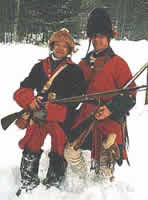 :
:
I acknowledged I entered upon this service, and viewed this small detachment of brave men march out, with no little concern and uneasiness of mind; for as there was the greatest reason to suspect, that the French were, by the prisoner and deserter, fully informed of the design of sending me out upon Putnam's return; what could I think, to see my party, instead of being strengthened and augmented, reduced to less than one-half of the number first proposed. I must confess it appeared to me (ignorant and unskilled as I then was in the politics and arts of war) incomprehensible; but my commander doubtless had his reasons, and is able to vindicate his own conduct.
The Patrol
Rogers and his rangers, 184 men in all, departed from their camp on the island at Fort Edward at about mid-afternoon on 10 March 1758 and, Rogers recorded, "marched to the half-way brook, in the road leading to Lake George and there encamped the first night."
On the second day of the patrol, the rangers marched to Lake George, passing the burned out ruins of Fort William Henry, then, proceeding onto the frozen surface of the lake, the column advanced as far as the Narrows and camped that night on the east side of the lake. Rogers, as might be expected, was acutely conscious of security. After dark he sent a small patrol three miles north to observe the lake, and placed listening posts and sentries around his camp.
On the third day of the patrol, 12 March 1758, the listening posts were brought in and the march resumed at sunrise, the rangers moving in extended order up the lake, using ice creepers on their feet, snowshoes stowed on their packs. Rogers kept the men close to the east bank so as to minimize observation on the lake.
 About three miles up the lake, the point spotted a dog running across the ice. Rogers immediately pulled his party into the fur trees along the east shore and sent a small reconnaissance party forward to investigate the islands that lay just ahead because of the possibility of ambush. Everyone knew that dogs frequently accompanied parties of Indians. Loescher suggests that the lost dog may actually have belonged to the war party of fifteen Indians that attacked a local patrol near Fort Edward on the morning of 12 March 1758. Rogers was taking no chances. His recon party returned with a negative report. Nevertheless Rogers ordered ice creepers removed, snowshoes donned, and took his force into the woods where they moved parallel to the east shore of the lake as far north as Sabbath Day Point on the opposite side. Although they reached this point by ten in the morning the men must have been exhausted from the tiring, unnatural gait required to use snowshoes effectively. Rogers decided to lay up for the remaining daylight hours, officers keeping the surface of the lake under observation through "prospective glasses," i.e. telescopes, while his men rested.
About three miles up the lake, the point spotted a dog running across the ice. Rogers immediately pulled his party into the fur trees along the east shore and sent a small reconnaissance party forward to investigate the islands that lay just ahead because of the possibility of ambush. Everyone knew that dogs frequently accompanied parties of Indians. Loescher suggests that the lost dog may actually have belonged to the war party of fifteen Indians that attacked a local patrol near Fort Edward on the morning of 12 March 1758. Rogers was taking no chances. His recon party returned with a negative report. Nevertheless Rogers ordered ice creepers removed, snowshoes donned, and took his force into the woods where they moved parallel to the east shore of the lake as far north as Sabbath Day Point on the opposite side. Although they reached this point by ten in the morning the men must have been exhausted from the tiring, unnatural gait required to use snowshoes effectively. Rogers decided to lay up for the remaining daylight hours, officers keeping the surface of the lake under observation through "prospective glasses," i.e. telescopes, while his men rested.
With darkness, the rangers continued their march north on the lake, scouts on ice skates moved out to the front. The legendary Lieutenant "Bill" Phillips took the point, and Ensign Andrew Ross, a Scottish volunteer from the Royal Highland Regiment, the "Black Watch," led a flank guard that marched along the west shore of the lake covering the main party against surprise from that quarter. Rogers himself kept the main body closed up to prevent separation in the darkness.
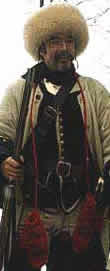 The rangers were within eight miles of the French advanced post located on Bald Mountain when Lieutenant Phillips reported sighting a fire on the east side of the lake. Rogers ordered the main party to drop packs and advanced in hopes of taking prisoners but, in the event, the fire could not be located and Rogers concluded that Phillips had only seen a patch of snow or rotted wood turned phosphorescent in the darkness. The rangers recovered packs, crossed the lake and established a defensive position on the west shore, where the command rested for the remainder of the night.
The rangers were within eight miles of the French advanced post located on Bald Mountain when Lieutenant Phillips reported sighting a fire on the east side of the lake. Rogers ordered the main party to drop packs and advanced in hopes of taking prisoners but, in the event, the fire could not be located and Rogers concluded that Phillips had only seen a patch of snow or rotted wood turned phosphorescent in the darkness. The rangers recovered packs, crossed the lake and established a defensive position on the west shore, where the command rested for the remainder of the night.
The Day of the Battle
The fourth day of the patrol, ill-fortuned 13 March 1758, opened with an "O group" or officers meeting. The council of war unanimously concurred with Rogers that the patrol should don snowshoes and push inland to the west circling behind Bald Mountain, keeping out of sight of the French advanced post there. The rangers moved out at seven a.m. and marched on snowshoes until eleven a.m. when they halted and ate a cold meal on the back of a ridge opposite the French outpost. There the rangers waited for the daily French relief and resupply party to return. By three p.m., Rogers judged that the daily French patrol must have passed and his men had regained their strength after the four hour morning snowshoe march. Rogers ordered the rangers to continue the march down the valley of Trout Brook "thinking to lay an Ambush on Some of their roads in ye Night, & meet with them in the morning without being discovered."
The rangers marched in three divisions, Captain Charles Bulkeley commanded the point, Rogers himself the main body and Ensigns James White and Joseph Waite brought up the rear guard, with the frozen Trout Brook close on the left and Bald Mountain and the French outpost off to the right.
Unknown to Robert Rogers and his men, the French at Ticonderoga had been reinforced by Sieur La Durantaye of the Companies Franche de la Marine with thirty French marines and 200 Iroquois and Nipissing Indians from Sault Saint Louis and the Lake of the Two Mountains who had arrived at Fort Carillon the previous evening, 12 March 1758. According to legend, the Indians held council that night and their medicine man prophesied that an English war party was out. Thus, when the news reached Captain De Hebecourt, the commander at Fort Carillon, that Indians returning north had crossed the trail of 200 men on snowshoes where the rangers had struck inland from the west shore of Lake George, Sieur La Durantaye's Indians could hardly be restrained.
So it was that La Durantaye, with ninety-five men, mostly Indians, set out along Trout Brook approximately fifteen minutes before Sieur De Langy, the famous partisan fighter, mustered a 200 man plus reaction force of French marines, Canadian militia and Indians and set out hot on Sieur La Durantaye's trail. As these three parties moved toward contact the events are set in motion that would result in the Battle on Snowshoes.
The Battle on Snowshoes: Phase One
Roger's narrative describes the first, or contact, phase of the battle.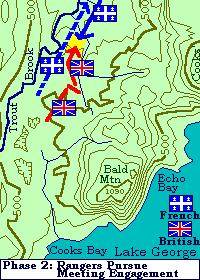
-We kept close to the mountain, that the advanced guard might better observe the rivulet, on the ice of which I imagined the enemy would travel if out, as the snow was four feet deep, and very bad travelling on snow shoes
- In this manner we marched a mile and a half, when our advanced guard informed me of the enemy being in their view; and soon after, that they had ascertained their number to be 96 chiefly Indians. We immediately laid down our packs, and prepared for battle, supposing these to be the whole number or main body of the enemy, who were marching on our left up the rivulet, upon the ice, and would come within 15 Rods of My party by the Course they then Steered
I orderd Ensign [Gregory] McDonald to the command of the advance guard, which, as we faced to the left, made a flanking party to our right. We marched to within a few yards of the bank, which was higher than the ground we occupied; and observing the ground gradually to descend from the bank of the rivulet to the foot of the mountain, we extended our party along the bank for enough to command the whole of the enemies at once
We waited until their front was nearly opposite to our left wing, when I fired a gun, as a signal for a general discharge upon them; whereupon we gave them the first fire, which killed about forty Indians, the rest retreated. My party pursued them & Scalped about forty Indians in about one quarter of an hour
Thus ended phase one of the battle, a classic hasty ambuscade delivered with devastating surprise. But now, because of the accidental fact that the French and Indians started in two parties fifteen minutes apart, the ambushers were, in turn, about to be ambushed with equally devastating effect.
The Battle: Phase Two
The veteran Langy, hearing the firing to his front, deployed his two hundred and five men, mostly French marines and Canadian militia, and advanced in a rough line of battle. Within minutes Langy's force received the approximately fifty-five fleeing survivors of Durantaye's force hotly pursued by Ensign Gregory MacDonald's right flank guard followed by virtually the whole of Captain Charles Bulkeley's division including lieutenants Increase Moore, Archibald Campbell, James Pottinger and Ensign James White. The exultant rangers ran straight into Langy's volley, delivered at close range in total surprise. Captain Bulkeley and all his officers were killed or wounded in the deadly fusillade. Lieutenant Moore and Ensign MacDonald, both mortally wounded, managed to rally the survivors and fall back, hard pressed by Langy and Durantaye, to Roger's main body before they died.
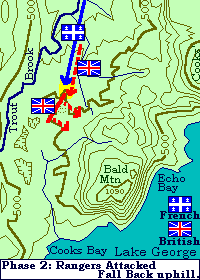 Rogers himself was unable to form the remaining rangers into line facing the attacking French and Indians. Some rangers were caught scalping and searching the dead at the first ambush site, others were scattered through the woods where they had followed Bulkeley's men in pursuit of the defeated Indians. Now as the French counter-attack came in on his right, Rogers found his flank turned and himself in danger of being enveloped. Rogers, a superb combat leader, was nothing if not mentally and emotionally resilient. He took in the chaotic situation and made his decision in a moment, ordering the rangers to fall back toward the high ground of Bald Mountain. If he could not break contact he would make his stand there. Thus ended phase two of the battle. Phase three, the rangers "last stand" was about to begin.
Rogers himself was unable to form the remaining rangers into line facing the attacking French and Indians. Some rangers were caught scalping and searching the dead at the first ambush site, others were scattered through the woods where they had followed Bulkeley's men in pursuit of the defeated Indians. Now as the French counter-attack came in on his right, Rogers found his flank turned and himself in danger of being enveloped. Rogers, a superb combat leader, was nothing if not mentally and emotionally resilient. He took in the chaotic situation and made his decision in a moment, ordering the rangers to fall back toward the high ground of Bald Mountain. If he could not break contact he would make his stand there. Thus ended phase two of the battle. Phase three, the rangers "last stand" was about to begin.
The Battle: Phase Three
The French and Indians, perhaps seeing that the destruction of Rogers' hated rangers was at last within their grasp, pressed their attack so closely that the rangers could not break contact. Rogers later wrote in his journal that he lost fifty men in getting to the high ground.
The remainder I rallied, and drew up in pretty good order, where they fought with such intrepidity and bravery as obliged the enemy to retreat a second time; but we not being in a condition to pursue them, they rallied again, and recovered their ground, and warmly pushed us in front and both wings, while the mountain defended our rear."
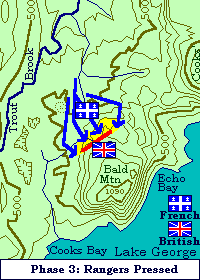 Loescher, the historian of Rogers Rangers, estimates that Rogers now had not more than 120 men, many wounded, on his firing line. Ensign Joseph Waite and the ten men of his rear guard, on the left, were cut off and overwhelmed in the confusion as the rangers scrambled up toward the high ground. The officer and one man succeeded in escaping the carnage and fled into the woods.
Loescher, the historian of Rogers Rangers, estimates that Rogers now had not more than 120 men, many wounded, on his firing line. Ensign Joseph Waite and the ten men of his rear guard, on the left, were cut off and overwhelmed in the confusion as the rangers scrambled up toward the high ground. The officer and one man succeeded in escaping the carnage and fled into the woods.
The French and Indians, well handled by Langy and Durantaye, pressed the rangers on all sides and attempted to envelop the perimeter around both flanks. The rangers' position held, however, and "they were so warmly received that their flanking parties soon retreated to their main body with considerable loss. This threw the whole again into disorder, and they retreated a third time."
However Rogers found a resumption of the offensive impossible. "Our number being now too far reduced to take advantage of their disorder, they rallied again, and made a fresh attack upon us." The French and Indians, infuriated by the sight of scalped corpses, victims of the first ambush, threw themselves into repeated assaults and, as casualties continued to mount, Rogers position became more and more precarious.
Most of the Indians seemed concentrated on the English right where, under Lieutenant William Phillips, the perimeter was first strained to the breaking point. But soon Rogers, who had now been in action about an hour and a half, was patching and filling everywhere.
Lieutenant Phillips informed me that about 200 Indians were going up ye hill on our right to take possession of ye rising ground upon our backs. . . I ordered him with 18 Men to take possession of ye rising Ground before the Enemy, & try to beat them back. Accordingly he went, but I being Suspicious that ye Enemy would go round on our left & take possession of the other part of the hill, I sent Lieutenant [Edward] Crofton with 15 Men to take possession of the ground there and soon after desired Captain Pringle to go with a few men & assist Crofton, which he did with Lt. Roche & 8 Men. But the Enemy pushed So close in the front that the party's were not more than 20 yards apart & oftentimes intermixed with each other.
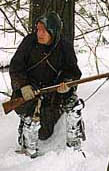 Darkness was now approaching and Rogers, having lost eight of fourteen officers and over 100 men, sought only to hang on until nightfall. Rogers himself with Ensign Joseph Waite held the center with some thirty-one men still effective. Phillips held the right flank with eighteen men, not nearly enough, while Crofton and Pringle held the left with twenty-three.
Darkness was now approaching and Rogers, having lost eight of fourteen officers and over 100 men, sought only to hang on until nightfall. Rogers himself with Ensign Joseph Waite held the center with some thirty-one men still effective. Phillips held the right flank with eighteen men, not nearly enough, while Crofton and Pringle held the left with twenty-three.
Langy and Durantaye were equally determined to finish the rangers before they could break up and escape in the darkness. The final assault came in from all sides but Lieutenant Phillips on the right was the first to be cut off and overwhelmed. He attempted to surrender on terms and did receive assurances of quarter. However, once in enemy hands scalps were discovered on the persons of the survivors and most "were inhumanly tied up to trees" and hacked to death by the enraged Indians.
Only Phillips and three others survived. They were eventually taken north where they were paraded and exhibited as "live letters" through the Indian villages around Montreal. After a series of harrowing experiences, Phillips, the only ranger officer captured alive, escaped and made his way back to British lines. The fate of the other three MIA's is unknown but can be surmised. They never returned to New England.
While Lieutenant Phillips and his men were surrounded but still fighting, Rogers and Ensign Joseph Waite continued to hold the center while casualties mounted. Finally, their strength now down to about twenty men, their right flank cut off from Phillips and the enemy so close that combat was virtually hand to hand, Rogers ordered his men to fall back upon Crofton and Pringle holding the left. Rogers wrote:
Upon finding that Phillips & his party was obliged to Surrender, I thought it most prudent for me to retreat & bring off as many of my people as I possibly could. Which I immediately did.
Lieutenant Henry Pringle, writing later as a French prisoner, described the conclusion of the action to his former commanding officer:
Capt. Rogers with his party came to me, and said (as did all those with him) that a large body of Indians had ascended to our right; he likewise added, what was true, that the combat was very unequal, that I must retire, and he would give Mr. Roche and me a Sergeant to conduct us thru the mountain. No doubt prudence required us to accept his offer; but, besides one of my snowshoes being untied, I knew myself unable to march as fast as was required to avoid becoming a sacrifice to an enemy we could no longer oppose. I therefore begged of him to proceed and then leaned against a rock in the path, determined to submit to a fate I thought unavoidable. Unfortunately for Mr. Roche, his snow-shoes were loosened likewise, which obliged him to determine with me, not to labour in a flight we both were unequal to.
In the event Pringle and Roche both managed to escape from the battlefield in the darkness. They wandered in the forest half frozen until 20 March 1758, seven days later, when they reached Fort Carillon and succeeded in surrendering to French officers before the Indians encamped around the fort could claim them as captives.
The Battle: Phase Four
Rogers, now in the last extremity, ordered his command to scatter and evade the enclosing enemy individually. The designated rally point was to be the place on the west shore of Lake George where they had left their sleds and packs so many hours before. In this Rogers was following his own advice as previously set forth in Rule No. X of his "Rules for Ranging Service":
If the enemy is so superior that you are in danger of being surrounded by them, let the whole body disperse, and every one take a different route to the place of rendezvous appointed for that evening which must every morning be altered and fixed for the evening ensuring, in order to bring the whole party, or as many of them as possible together, after any separation that may happen in the day; but if you should happen to be actually surrounded, form yourselves into a square, or, if in the woods, a circle is best, and, if possible, make a stand till the darkness of night favors your escape.
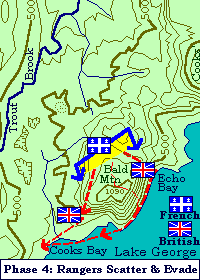 As the rangers dispersed into the gathering gloom Rogers threw off his uniform coat which was later discovered on the battlefield by the French. In the pocket was found his captain's commission, dated 24 March 1756 and signed by Sir William Shirley. The French were briefly convinced that Rogers was indeed among the dead. One Iroquois warrior later boasted to Governor Vaudreuil that "he had himself killed him." Rogers actually made good a legendary escape, supposedly climbing up the west slope of Bald Mountain and then sliding down the smooth, frozen, near vertical, east face of the mountain to the surface of Lake George over a thousand feet below. Loescher suggests that he back-tracked to the lip of the cliff in order to convey the impression to his pursuers that he had actually used "Roger's Slide." Rogers does not mention his escape, saying only that "the Indians closely pursuing us at the same time, took several prisoners."
As the rangers dispersed into the gathering gloom Rogers threw off his uniform coat which was later discovered on the battlefield by the French. In the pocket was found his captain's commission, dated 24 March 1756 and signed by Sir William Shirley. The French were briefly convinced that Rogers was indeed among the dead. One Iroquois warrior later boasted to Governor Vaudreuil that "he had himself killed him." Rogers actually made good a legendary escape, supposedly climbing up the west slope of Bald Mountain and then sliding down the smooth, frozen, near vertical, east face of the mountain to the surface of Lake George over a thousand feet below. Loescher suggests that he back-tracked to the lip of the cliff in order to convey the impression to his pursuers that he had actually used "Roger's Slide." Rogers does not mention his escape, saying only that "the Indians closely pursuing us at the same time, took several prisoners."
The Retreat
Rogers reached Lake George about 8 p.m. on 13 March 1758 and struck out for the rendezvous. He soon met other survivors including several wounded. He collected the survivors at the rally point and immediately sent two rangers, on ice skates, south for Fort Edward with requests for a relief force. Four severely wounded men were put on sleighs, with two men each to pull, and also sent south. Rogers kept the remaining handful of survivors in a perimeter around the rally point where they were able to collect other evaders as they came in, though the men almost froze that night without fire or blankets.
By the morning of 14 March 1758, several more rangers arrived, some also wounded. At daybreak they started south for Fort Edward where his first messengers arrived at noon and informed the garrison that Rogers "Had a Hot Ingagment Such as Scare Even was Knowed in ye Country & Most of His Party Destroyed."
Lieutenant Colonel Haviland ordered three companies of rangers, Stark's, Shepard's and Durkee's, to Rogers' support. They met the survivors at Sloop Island, six miles from the head of Lake George. Rogers spent the night of 14-15 March on Sloop Island, and sent again to Fort Edward for three horse-drawn sleighs to carry his remaining wounded. These arrived in the morning under the command of Lieutenant John Belscher, 27th Regt. of Foot. 15 March 1758 was described by Jabez Finch as "a Vast Cold & Tedious Day Espacially for ye Wounded Men." The defeated rangers trickled into Fort Edward in small groups from about 3 p.m. Rogers, bringing up the rear, reached the fort about 5 p.m. He had brought with him fifty-two survivors, eight badly wounded. He had lost 124 men and one more, his own orderly, died of the cold during the retreat.
Conclusion
Rogers estimated that about forty French and Indians were killed in the initial ambush and another sixty killed in the subsequent action. He estimated the enemy wounded at no less than 100. However Captain Hebecourt's report to General Montcalm listed his casualties as eight Indians killed, seventeen Indians wounded and two died of wounds, three Canadians wounded.
Rogers dictated his journal account of the action on 17 March 1758, four days after the battle. On 6 April 1758, General Abercromby confirmed Rogers' promotion to "Major of the Rangers in His Majesty's Service." It was a vote of confidence in the defeated partisan that subsequent events would more than justify. Now Rogers set about the task of reconstructing his shattered force.
To Read More on the Battle on Snowshoes
Accounts of the battle are found in Burt Loescher, The History of Rogers' Rangers, in Francis Parkman's classic Montcalm and Wolfe, and in Lawrence Henry Gipson's The Great War for the Empire: The Victorious Years, 1758-1760, as well as in John Cuneo's biography, Robert Rogers of the Rangers. See also Gary Zaboly's "The Battle on Snowshoes," American History Illustrated, Dec. 1979, 12-24.
Dr. Joseph F. Meany Jr., a member of the Advisory Board of the New York State Military Heritage Institute, is a Senior Historian at the New York State Museum in Albany, New York.
NOTE: The photographs accompanying this article are from a recreation by the Company of Military Historians
